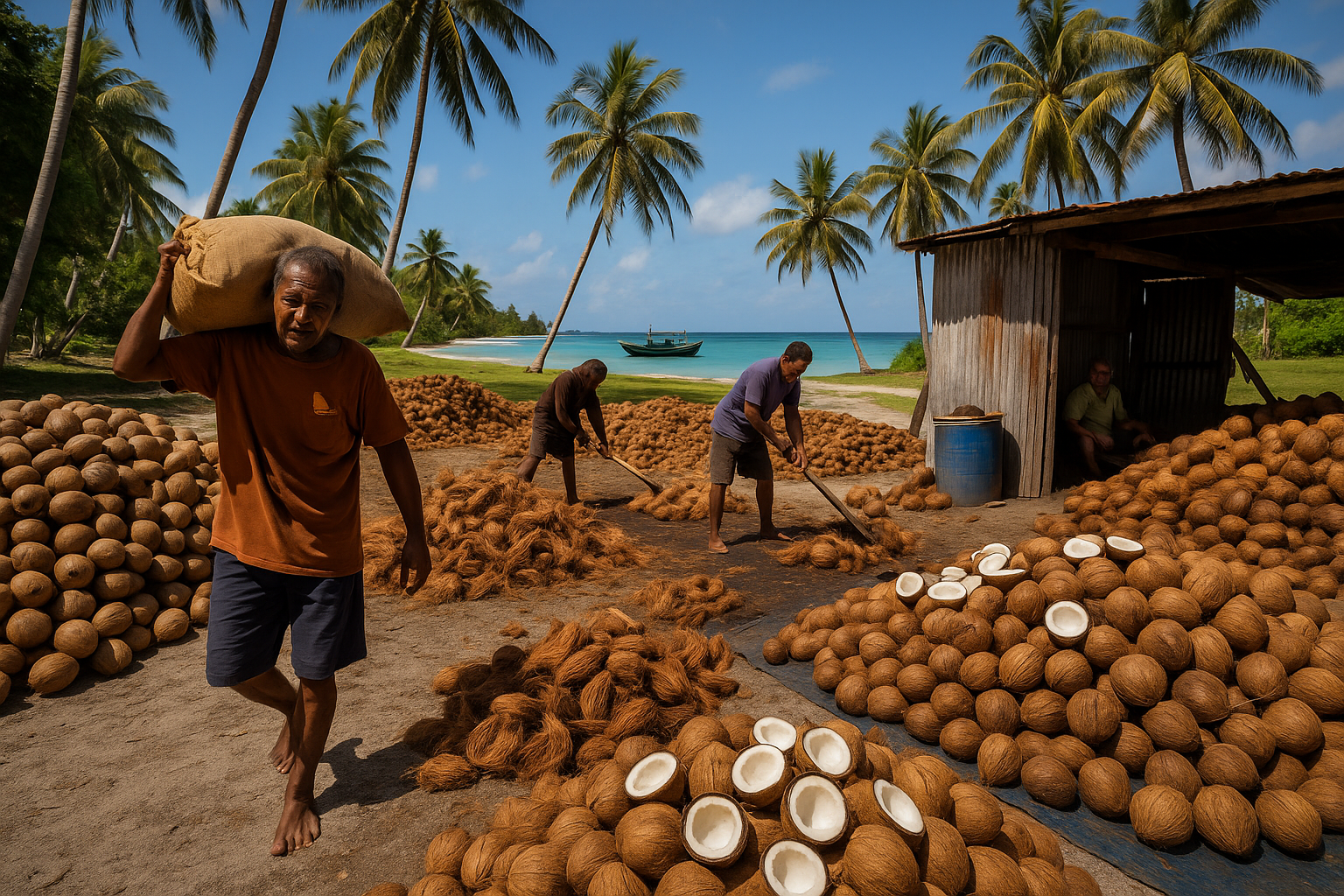Cracking the Copra Trap: How Kiribati Can Transform Its Coconut Industry for Growth
The World Bank’s report proposes phasing out Kiribati’s costly copra subsidy and restructuring its coconut sector to boost efficiency, attract investment, and diversify into high-value products like VCO and young coconuts. Reforms in land governance, shipping, and social protection are key to unlocking sustainable growth.

The World Bank’s Finance, Competitiveness and Innovation (FCI) and Macro, Trade and Investment (MTI) teams have collaborated on a striking policy proposal titled Cracking the Nut, setting out an ambitious roadmap for reforming Kiribati’s coconut industry. Developed in consultation with key government institutions, such as the Ministry of Finance and Economic Development (MFED), Ministry of Environment, Lands and Agriculture Development (MELAD), and Ministry of Commerce, Industry and Cooperatives (MCIC), the report forms part of a broader agenda to diversify the economy and strengthen social protection. Given the country's extreme data scarcity, the study relies heavily on qualitative assessment, informed by limited statistics and targeted stakeholder feedback.
A Costly Safety Net Built on Unsustainable Grounds
Kiribati’s economy is uniquely shaped by its geography: 33 isolated atolls scattered across 3.5 million square kilometers of ocean, with limited arable land and vulnerable infrastructure. In this challenging context, copra production, dried coconut meat processed into crude coconut oil (CNO), has historically offered outer island households a lifeline. However, the government’s AUD 4/kg subsidy, while providing vital cash income to remote communities, now represents a massive fiscal liability. In 2022, it accounted for 12% of GDP, dwarfing the AUD 4 million generated through exports of CNO. The system pays approximately AUD 0.65–0.80 per coconut, yet returns only AUD 0.20 after processing, an unsustainable model exacerbated by the volatility of fishing license revenues that finance it.
The current structure is a complex web of state-owned enterprises (SOEs) managing every aspect of the value chain. MELAD oversees seedling distribution, Island Councils run weigh stations, the Kiribati National Shipping Line (KNSL) manages transportation, and the Kiribati Coconut Development Ltd (KCDL) handles processing and export. This multi-layered state control fosters inefficiencies, misaligned incentives, and minimal accountability. Moreover, the inflated copra price discourages innovation, locks out new market entrants, and disincentivizes farmers from exploring higher-value coconut products.
Restructuring for Efficiency and Resilience
The report recommends a phased reduction in the subsidy, benchmarking the price to international standards, such as those in the Philippines and Fiji, and adjusting it annually based on market conditions. It also proposes shifting purchasing responsibilities to KCDL, creating incentives for quality control and operational efficiency. This would replace the current model, in which copra is bought regardless of quality and often suffers from spoilage, rodent infestations, and theft due to poor storage and unreliable shipping schedules. Reports suggest up to 30% of inventory is lost between purchase and export, sometimes due to repurchasing previously bought copra.
To address transport inefficiencies, the report advocates for performance-based contracts (PBCs) for inter-island shipping, modeled on successful schemes in the Solomon Islands. These contracts would introduce competition, improve service reliability, and lower government costs. At the same time, investments in cold chain logistics and port infrastructure, especially in outer islands, are deemed essential to reduce spoilage and enable exports of perishable, high-value coconut products.
Beyond Copra: Tapping into High-Value Coconut Products
Copra and crude coconut oil are now commodities in a low-margin global market. To escape this trap, the report envisions Kiribati’s transition toward high-value products like Virgin Coconut Oil (VCO) and packaged young coconuts, which command premium prices in regional markets. Unlike copra, these products offer better returns, especially given their perishability, which limits competition and supports localized value chains.
Currently, only small-scale VCO operations exist in places like Tabiteuea and Butaritari, and they struggle to compete due to the high subsidized price of dried copra. By reducing the subsidy, VCO could become viable, creating opportunities for small enterprises. The report also explores the introduction of distributed “mini mills,” which cost around USD 8,500 and can be leased to local operators. These mills not only reduce post-harvest spoilage but can potentially supply biofuel for outer island generators, cutting down on costly imported diesel.
Reforming Land to Unlock Investment Potential
One of the biggest bottlenecks to expanding agricultural investment is Kiribati’s land tenure system. About 60% of the land is government-owned, while the rest is held under customary collective titles. Registering land takes over 500 days on average. For investors, this creates prohibitive transaction costs and legal uncertainty. The report calls for urgent land reforms, including zoning and streamlined leasing on Kiritimati, the country’s largest but underutilized island.
To support plantation-style farming or long-term investment in coconut varieties suitable for VCO and young coconut segments, the government must offer long-term leases and create mechanisms for transferring land rights. Establishing representative landholder groups would make negotiations easier, and ensuring land and asset collateralization could finally unlock access to credit markets.
- FIRST PUBLISHED IN:
- Devdiscourse
ALSO READ
World Bank Approves $2.1B Package to Boost Jobs, Clean Energy in Indonesia
World Bank Launches $150M Program to Boost Sri Lanka’s clean energy transition
World Bank Urges SME Empowerment to Boost Inclusive Growth in Philippines
World Bank Expands Support for ASEAN Power Grid with New $7.7M Grant to ACE
World Bank Calls for Radical Debt Transparency in Developing Nations










